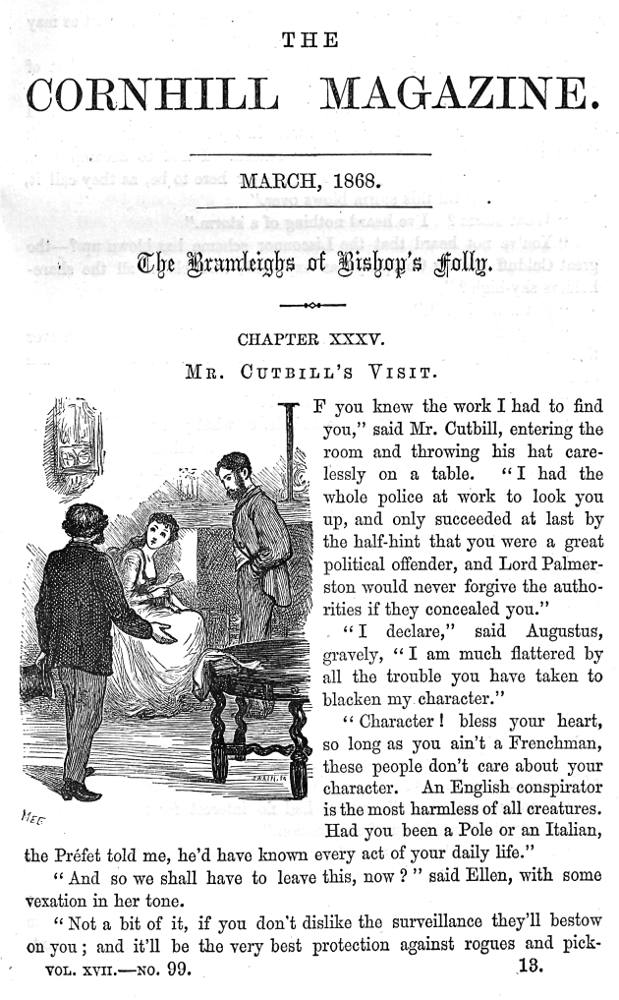

Initial-letter Vignette "I" — Augustus Bramleigh and his sister, Nelly, greet their business agent, Mr. Cutbill (Vol. XVII, page 257), vertically-mounted, 7.5 cm high by 5 cm wide, signed "MEE." in the lower-left corner; also in the lower-left corner of the main illustration. Mary Ellen Edwards' initial thumbnail vignette illustration for the March 1868 number of Charles Lever's The Bramleighs of Bishop's Folly in the Cornhill Magazine, Chapters XXXV-XXXIX ("Mr. Cutbill's Visit" to "At Albano") in Vol. 17: pages 257 through 283 (26 pages including unpaged illustration in instalment). The wood-engraver responsible for this illustration was Joseph Swain (1820-1909), noted for his engravings of Sir John Tenniel's cartoons in Punch. [Click on the image to enlarge it; mouse over links.]
This initial-letter vignette introduces the passage at the opening of the chapter:
“If you knew the work I had to find you,” said Mr. Cutbill, entering the room, and throwing his hat carelessly on a table. “I had the whole police at work to look you up, and only succeeded at last by the half-hint that you were a great political offender, and Lord Palmerston would never forgive the authorities if they concealed you.”
“I declare,” said Augustus, gravely, “I am much flattered by all the trouble you have taken to blacken my character.”
“Character! bless your heart, so long as you ain't a Frenchman, these people don't care about your character. An English conspirator is the most harmless of all creatures. Had you been a Pole or an Italian, the préfet told me, he'd have known every act of your daily life.”
“And so we shall have to leave this, now?” said Ellen, with some vexation in her tone. [Vol. XVII, Chapter XXXV, "Mr. Cutbill's Visit," 257]
Commentary: Cutbill brings news of the Lisconnor Scheme's collapse
The capable but somewhat low-class business agent Tom Cutbill is the common element in these scenes from the March 1868 instalment. Whereas the main illustration for this instalment shows how George L'Estrange collapses emotionally under Cutbill's news of a financial reversal in their investments in "the Lisconnor scheme" (a coal-mine), the vignette depicts Cutbill's having misrepresented his search for the Bramleighs in order to secure the assistance of the local police prefect in locating them. His news from England is the same in both illustrations: the Lisconnor coal-mining venture has "blown up" (257) and the financial bubble for the Bramleighs and L'Estranges has burst, despite Lord Culduff's nominal chairmanship. The peer himself, married of course to Marion Bramleigh, stands to lose twenty-five thousand pounds. Augustus and Nelly do not seem especially distressed at this announcement, perhaps because they disapproved of their sister's marriage and her choice of husband. But they are concerned that the L'Estranges have lost two thousand pounds in the speculation, for they realize that Julia has lost her entire inheritance.
Scanned images and text by Philip V. Allingham. [You may use these images without prior permission for any scholarly or educational purpose as long as you (1) credit the person who scanned them and (2) link your document to this URL in a web document or cite the Victorian Web in a print one.]
Bibliography
Lever, Charles. The Bramleighs of Bishop’s Folly. The Cornhill Magazine 15 (June, 1867): pp. 640-664; 16 (July-December 1867): 1-666; 17 (January-June 1868): 70-663; 18 (July-October 1868): 1-403. Rpt. London: Chapman & Hall, 1872. Illustrated by M. E. Edwards; engraved by Joseph Swain.
Stevenson, Lionel. "Chapter XVI: Exile on the Adriatic, 1867-1872." Dr. Quicksilver: The Life of Charles Lever. London: Chapman and Hall, 1939. Pp. 277-296.
Created 7 September 2023